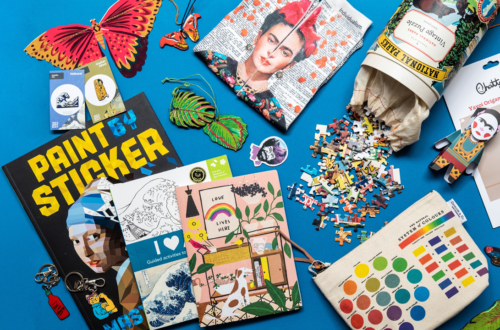In our first monthly department focus of 2021, we’ve chosen an area that is a universal challenge: the brush department. Brushes are, perhaps, the most specialized tool an artist will use in their practice. Every artist has their favorite brush. Watercolorists look for the perfect belly to hold their desired amounts of water while maintaining shape, muralists look for the brush that can hold up to the beating of brick or stucco walls, oil painters look for a brush that leaves no trace, and acrylic painters look for anything and everything.
How do you display your brushes so as to not overwhelm a novice artist, but provide structure for those with more refined tastes? How do you keep everything organized and properly priced? While there is much more to say (please do so in the comments!) we’ve pulled together some standard practices below.
Who Buys Brushes?
Brushes are a staple tool for a wide range of projects, from assignments and crafts to ongoing creative practices. The people wandering through your brush aisle may be students, professionals, makeup artists, cosplayers, designers or complete novices. Once you understand who the customer is and what they’ll be using their sought-after brush for, you can begin to build an impactful Brush Department that speaks to all your customers’ needs.
What Makes an Impactful Brush Department?
If you have the room, vendor provided displays provide excellent education and inspiration for shoppers, as well as breathing room for your merchandise. If you don’t have the room for these kinds of displays, there are ways to be creative. What’s most important is clear pricing, a clean and organized approach to merchandising, a diverse and distinguished collection and most importantly knowledgeable staff.
Crystal Clear Pricing
There is nothing more frustrating for a shopper than going to browse, but not finding prices for what they want. Imagine you went to the grocery store to buy fruit for a fancy platter. In the section with exotic fruits there is a spiky pink and green fruit next to a fuzzy red fruit, next to an orange and green globe…but no labels, or prices! If you don’t know what they are, you might touch them and marvel at how neat they look, but you’re going to stick to the apples and oranges you’re used to. The same logic applies to brushes. Here are three methods to think about:
- Map it out through the grid method.

Pros: If you color code, they are easy to read! When you have promotions, you can easily substitute a new grid in with the reduced pricing.
Cons: They can look messy if the department is crowded, they must be updated and replaced regularly to keep crisp. They require the customer to search for the correct brand and style of brush, which can be labor intensive for a new shopper.
How to make it work: Assist your customers by having a staff member present to explain the system, and reinforce their ability to help if there are any questions.
- Put individual stickers on each brush.
Pros: quick reference for shoppers. Less staff time required in the aisle.
Cons: Stickers risk getting stuck to one another or to the brush hair. It’s easy to swap stickers and have a customer debate pricing. Labor intensive upon receipt. Confusing when sales happen or pricing changes occur.
- Level the playing field and establish one price across the board.
Pros: Easy for shoppers, margin gains in some cases.
Cons: Margin losses in other cases.
Do you have any suggestions for pricing? Please leave information in the comments to share with the rest of the industry.
Clean, Neat Displays
Unlike the marker department, you can’t write on a display with a paintbrush, but you are at risk of dust, damaged brushes, and mixed merchandise. Ensure that you are giving this department a thorough clean monthly and that a staff member is sorting brushes no less than weekly. Not only does this help with having the right inventory in place, it is appealing as a shopper. Remember the fruit metaphor from before? If you wanted an orange but kept picking up mandarins or dusty clementines, you would be turned off and likely go without citrus.
Clearly Defined Mediums
Group your watercolor brushes, your acrylic and oil brushes, and call out your specialty brushes. If you are not using vendor displays, consider using icons on your displays like a teardrop for watercolor, an A for acrylic and O for oil.
(AA15620)
Accessible Accessories
When buying a brush, it’s a good time to stock up on cleaners, explore storage solutions, and learn new ways to care for these treasured tools. If you don’t have brush soap (like this from General Pencil or these from Winsor & Newton) within arms reach of your brush department, consider moving them closer. It’s worth merchandising items like mineral spirits in multiple locations in your store to capitalize on the needs of someone buying a brush, but not paint, that day. Or vice versa.
Other items to have nearby include:
- Silicoil Tanks
- Brush storage, like these from Art Alternatives or this from Art Bin.
- Palettes or storage jars
A Distinguished Collection
There are so many shapes of brushes, a lot have come from the craft market and have unique qualities. Everyone has round, flat or filbert, but angle shaders and daggers are just as important. Think about the possibilities miniature and detailed brushes unleash for hobbyists or sneaker painters. Ensure your collection can help sign painters and decorative painters alike.
How does a consumer differentiate between brands when it seems that all the brushes do the “same” thing? Encourage your store staff to pick a favorite and write a review!
Think about the way people shop for wine: This wine goes well with this fish, this one is a dessert wine. Pair and bundle your brushes the same way.
- Attach brushes to your paint display. Just like in a bookstore, providing a staff review for a brush next to the paint they use can guide shoppers to another part of your store.
- Create a call out or a monthly featured brush to draw attention to its unique features.
- Window shopping is more popular than ever, give your brush it’s close-up in front.
Knowledgeable Staff
Your best weapon in the brush department is the people you have representing you. Do your staff know how to properly care for a brush? Can they recommend the proper shape or hair for the painter in front of them? Ask your staff what their favorite brushes are, and encourage them to try new brushes if they haven’t.
If you have other suggestions for resources, please share them with your fellow retailers in the comments. We have some educational tools available to you in our Art Fundamentals on www.macphersonart.com, and this handy article on caring for brushes.







2 Comments
johanna
It would be awesome if you could show us pictures of the things you describe.
Cassie Brehmer, Account Manager • MacPherson's
Thanks for the feedback Johanna! Once I’m able to get into retail stores (still locked down here in Chicago) I’ll get some photos added in. We’ll add store photos to future posts as well. Is there anything specific you’d like an example of?